
PREV ARTICLE
NEXT ARTICLE
FULL ISSUE
PREV FULL ISSUE
BRITISH INDIA HALF RUPEE BUST VARIETYLeitton Rezaul of Bangladesh is a collector and researcher on British Indian Coinage. He submitted this article on a new die variety he's discovered. Thank you. -Editor
Let's take the example of one rupee coins, it can be noted that in regards to one rupee denomination many authors, experts, researchers and even senior collectors wrote their books, catalogues and articles on this one rupee coins and still they are doing their work on that and discovering new varieties, but comparatively this is rarely seen in case of other denominations. Many things are yet to discover in British Indian Coinage. Two new varieties of ½ rupee obverse of Bombay mint in Victoria Empress Period have been discovered which is described below with all the varieties introduced by Bombay mint in Victoria Empress Period. There are four types of Obverse bust that considered in ½ rupee coins in Victoria Queen's period, like: bust A, B1, B2 and C. Bust B1 and B2 used by Bombay mint. Bust A and C were used in Victoria Queen's period for Calcutta mint and they both had many differences in their jabot panel and bodice embroidery floral design. Bust A has a small raised V like design and in some specimen reverse tick like design as privy mark at the center point of the baseline of the bust, which used in both the Queen and Empress Period from 1862 to 1899 for Calcutta mint but bust C was not used after Queen's Period. In 1877, the very 1st year of empress period Bombay mint introduced a NEW BUST, which is similar to the old bust A. The new bust has a raised base line at the bottom of the bodice and some new embroidery floral designs, those embroidery floral designs are small but much prominent to identify the mint and do not match with old bust A which used by Calcutta mint from 1862 to 1899 (Queen and Empress both the period). The NEW BUST two images are shown below: 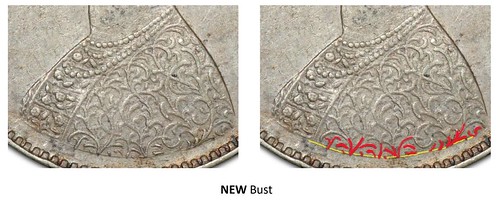
From the above images it can be noticed that - yellow line indicates the raised bottom line and red marking areas are indicating the new floral embroidery designs which is not matching with old A bust. Except those new designs, all embroidery floral designs are same with old bust A but the bodice embroidery design is little thicker than the old bust A. Let us consider to describe in detail with the split images below: 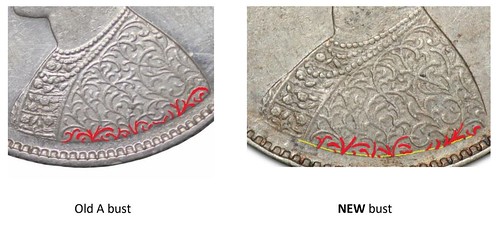
For better understanding the differences of those busts are explained in details by splitting it into two parts as shown below: Part - 1 
Left side image is from old A bust and Right side is from NEW BUST, the yellow line of NEW BUST indicates the raised line which absent in the old A bust. Both of these images have 7 black circles marked area and they show the embroidery floral design which reflects many differences between the two busts. Part–2 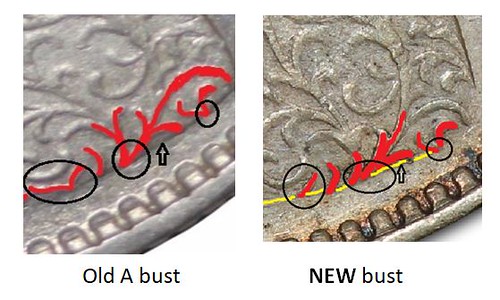
Left side image is from old A bust and right side is from NEW BUST both those images have three black circles which shows the different embroidery designs of both the busts and there is an arrow mark in both the images indicating the different gaps between the flower petal and base line of bodice. By considering all the above discussions and comparisons it can be said that it is a NEW BUST, and thus this bust deserves a new name. Since this bust is similar with old bust A, so it can be named as bust A1. Bombay mint introduced this A1 bust in 1877 and this bust always came with Reverse II. Surprisingly Bombay mint did not use this bust in later date (except any mule). No record was found for the A1 bust in later date of Victoria Empress Period and Bombay mint also used old B2 bust from 1877 to 1884 in ½ rupee of Victoria Empress Series which also came with Reverse II. In their next striking year (1881) of Victoria Empress Period for ½ Rupee coins, Bombay mint introduced another NEW BUST, and this bust is also similar with old bust A and new bust A1. This new bust also has a raised base line at the bottom part of the bodice like bust A1 but in some specimen bottom part of the bodice look like cut out. It has some prominent embroidery floral design at the bottom part of the bodice which does not match with old bust A or new A1, except those changes all embroidery designs are same. Below images are the new busts which introduced by Bombay mint in 1881: 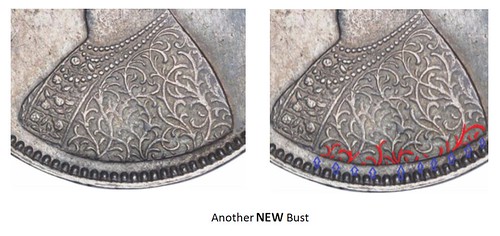
This is the new bust introduced by Bombay mint in 1881; those blue arrows show a raised base line at the bottom part of the bodice and new embroidery floral designs are shown by red color. The comparison of this NEW BUST with bust A1 is shown: 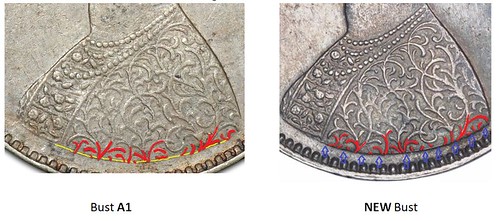
From the images above many differences on the floral embroidery design can be seen. The only similarity is the raised base line at the bottom part of the bodice but some floral designs have crossed the raised base line in bust A1 but in the NEW BUST no floral design has crossed the raised base line. For better understanding of the bust details, splitting the images of red marked floral embroidery designs area are done into two parts, as shown below: Part - 1 
Left side image is from bust A1 and right side image is from NEW BUST, each image has seven black circles and those circles indicate the embroidery floral design differences. It can be easily explained those differences particularly through each circle-marked area but here those circle marked areas are explain it all. 2nd part shown below: Part – 2 
Left side image is from bust A1 and the right side image is from the NEW BUST. Each image has three circle-marked areas to clearly indicate the design differences of the floral embroidery, and the only similarity between them is the arrow marked area; both have the same gaps in between floral design and base line of bodice. Based on all these discussions, evidence and comparison with other busts now it can be considered as a NEW BUST, and this bust is similar with old bust A and new bust A1. So it deserves the name as bust A2. Bombay mint introduced this A2 bust in their 2nd ½ rupee striking year of Victoria Empress Period 1881 and from there on, most of the year they used this bust and this bust came with all the Reverse I, II and II (i), but there are few specific years where this bust has not been recorded yet, for example 1899. In 1882 (3rd ½ rupee striking year of Empress Period for Bombay mint, 1st at 1877, 2nd at 1881), they introduced another NEW BUST which is pretty simple. Pridmore mentioned in his book about this variety as the only A bust variety of Bombay mint in Empress Period (page 126). Bombay mint used the old A bust design which used by Calcutta mint in both Queen and Empress Period from 1862 to 1899. In the old A bust there is a small raised V like design and in some specimen reverse tick like design as privy mark at the center point of the baseline of the bodice. However, in that NEW BUST there is no small privy mark raised V or reverse tick in the center point of the base line of the bodice but only the left stroke of raised V or reverse tick as privy mark. Pridmore also mentioned about this privy mark (page 126) which is confusing. This bust actually came with both the Reverse I and II(i) with no changing of the privy mark in bodice, Pridmore also mentioned about this bust with modern proof restrike in 1877 (page 127). The most interesting thing is that, this variety was known as the only Bombay minted A bust variety of ½ rupee coins in Victoria Empress Period before this article. For better understanding of the bust details, splitting the images of red marked floral embroidery designs area are done into two parts, as shown below: 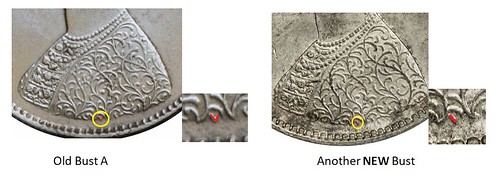
In old bust A there is a raised V or reverse tick like privy mark in the center point of the base line of bodice (above left image) and in the NEW BUST there is only the left stroke in the same point of bodice (above right image). Except that little change, all embroidery designs are same as old A bust. That difference is a minor one but much noticeable to identify the mint, so it is easily consider as a new variety. Considering Bombay mint issuance of varieties over the subsequent years, this variety may deserve a new name as bust A3. Based on all findings, information, comparisons and analysis, it is evident that in total Bombay mint used four different busts for their ½ rupee Obverse in Victoria Empress Period: Bust B2 from 1862 to 1884 (both Queen and Empress Period), Bust A1 only used in 1877 (no record found for further years), Bust A2 from 1881 to 1898 (no record found yet in 1899) and Bust A3 from 1882 to 1899. Interesting enough, there are few dates where A2 and A3 were very difficult to get, such as, A3 is available in 1897 but not too easy to get in 1898, there are few mules exist in ½ rupee of Victoria Empress Series as well. Below images, showing all the busts used by Bombay mint in Victoria Empress Period: 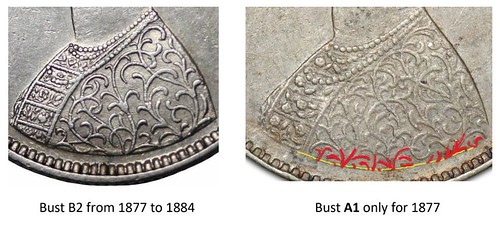
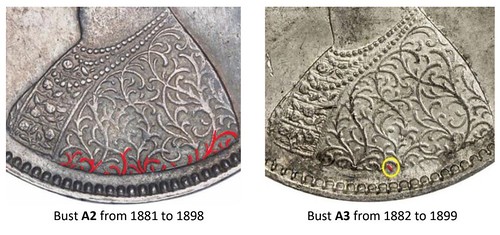
This article is based on circulated coins only and it is very important for serious collectors who like to collect rare, mule and unlisted variety of ½ Rupee coins in Victoria Empress Series. REFERENCES: THE COINS OF THE BRITISH COMMONWEALTH OF NATIONS, Part - 4 India. Volume 2 : Uniform Coinage East India company 1835-58 and Imperial Period 1858 - 1947. Author - F. Pridmore Standard Catalogue of Coins of British India 1835 to 1947 Currency Issues Author - Gev Kias and Dilip Rajgor. The Uniform Coinage of India 1835 to 1947 A Catalogue AND Pricelist Author - Paul Stevens & Randy Weir SPINK 
Wayne Homren, Editor The Numismatic Bibliomania Society is a non-profit organization promoting numismatic literature. See our web site at coinbooks.org. To submit items for publication in The E-Sylum, write to the Editor at this address: whomren@gmail.com To subscribe go to: https://my.binhost.com/lists/listinfo/esylum All Rights Reserved. NBS Home Page Contact the NBS webmaster 
|
